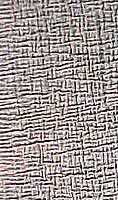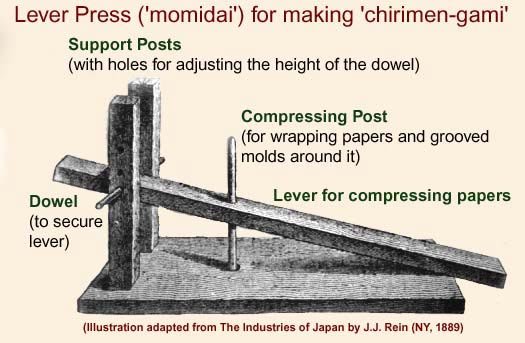

FAQ: How were crepe prints (縮緬紙) made?
Over the course of the nineteenth century, there were different methods and devices used in making a chirimengami-e, such as wooden presses, paper molds, wood molds, and even walking upon prints rolled inside thick paper blankets. The crinkling effect ranged from fairly fine to rather coarse, with differing “pitch angles” of the paper wrinkles. Chirimengami-e were very uncommon before 1840; most surviving specimens date from the 1840s to the 1910s, with a spike in productivity during the 1850s) The effect of the wrinkled surface varied according to the light source. When viewed in low-level illumination (e.g., candlelight or kerosene lamp), the visual impact could be dramatic. A modest revival of chirimengami-e production took place in the 1880s with the advent of crepe-paper books intended to satisfy a growing Western market. Best known are those published by the Hasegawa company, which was opened in 1885. Their chirimengami publications were especially popular for children's books, as the crepe paper was somewhat resistant to tearing and thus had a better chance of surviving handling by children. One method of making chirimengami has been documented (see the illustration below). Also see Detail of a chirimengami-e. After the image and inscriptions were printed in the usual fashion, the dampened printed sheets were interleaved with thick kôzo paper (楮紙) repeatedly coated with persimmon juice (tannin). Cardboard molds (kata) that were incised with parallel grooves. were then wrapped together with the print and kôzo paper around a vertically mounted cylindrical wooden post roughly 3cm in diameter. This post had a fixed collar at the bottom to secure the wrapped sheets of paper. The upper part of the post had a loose collar that also held the papers and was moved downward by a wooden lever. At about 1/3 from one end of this lever there was a hole drilled wide enough so that the lever could move freely a short distance up and down. The lever was unattached at the end held by the person making the chirimengami but hinged at the end closest to the vertical post by a dowel run through the lever and mounted horizontally between two vertical supports.
By pressing the lever down an enormous amount of pressure could be exerted upon the papers and molds, thus compressing the papers and imparting a textured effect from the molds to the interleaved, dampened papers. Multiple pressings were applied after arranging the sheets slightly differently following each compression, and this was done 10 times or more to gain the desired crinkled and compressed effect (see enlarged textural detail, top right of this page). The process not only crinkled the papers but reduced their size significantly while still maintaining the proportions of the images and text in all dimensions. After the process of "creping" was completed, an untrimmed ôban print (ranging in size from approximately 360 x 240 to 385 x 360 mm) could measure as small as 260 x 190 mm. ©2023 by John Fiorillo BIBLIOGRAPHY
Return to FAQ |
Viewing Japanese Prints |
 Chirimengami-e ("compressed thread paper prints": 縮緬紙) were crinkled paper prints or "crepe" prints (sometimes referred to as 'crepon'). Ukiyo-e crepe prints were produced at least as early as 1800 in Edo, and throughout the nineteenth century they were used on occasion for alternate states of some ukiyo-e designs. The compression technique resulted in a highly textured surface and noticeably smaller paper sizes, which offered a different aesthetic from the image printed in standard editions. Despite the extra effort involved in making these prints, they were, it seems, more a novelty than an attempt at serious refinement of the printed image.
Chirimengami-e ("compressed thread paper prints": 縮緬紙) were crinkled paper prints or "crepe" prints (sometimes referred to as 'crepon'). Ukiyo-e crepe prints were produced at least as early as 1800 in Edo, and throughout the nineteenth century they were used on occasion for alternate states of some ukiyo-e designs. The compression technique resulted in a highly textured surface and noticeably smaller paper sizes, which offered a different aesthetic from the image printed in standard editions. Despite the extra effort involved in making these prints, they were, it seems, more a novelty than an attempt at serious refinement of the printed image. 